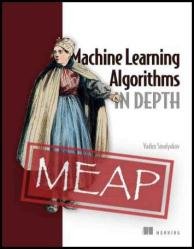 Название: Machine Learning Algorithms in Depth (MEAP v3)
Название: Machine Learning Algorithms in Depth (MEAP v3)Автор: Vadim Smolyakov
Издательство: Manning Publications
Год: 2023
Страниц: 186
Язык: английский
Формат: pdf, epub
Размер: 11.97 MB
Develop a mathematical intuition for how Machine Learning algorithms work so you can improve model performance and effectively troubleshoot complex ML problems.
In Machine Learning Algorithms in Depth you’ll explore practical implementations of dozens of ML algorithms including:
Monte Carlo Stock Price Simulation
Image Denoising using Mean-Field Variational Inference
EM algorithm for Hidden Markov Models
Imbalanced Learning, Active Learning and Ensemble Learning
Bayesian Optimization for Hyperparameter Tuning
Dirichlet Process K-Means for Clustering Applications
Stock Clusters based on Inverse Covariance Estimation
Energy Minimization using Simulated Annealing
Image Search based on ResNet Convolutional Neural Network
Anomaly Detection in Time-Series using Variational Autoencoders
Machine Learning Algorithms in Depth dives into the design and underlying principles of some of the most exciting Machine Learning (ML) algorithms in the world today. With a particular emphasis on probability-based algorithms, you’ll learn the fundamentals of Bayesian inference and deep learning. You’ll also explore the core data structures and algorithmic paradigms for Machine Learning. Each algorithm is fully explored with both math and practical implementations so you can see how they work and how they’re put into action.
about the technology
Fully understanding how Machine Learning algorithms function is essential for any serious ML engineer. This vital knowledge lets you modify algorithms to your specific needs, understand the tradeoffs when picking an algorithm for a project, and better interpret and explain your results to your stakeholders. This unique guide will take you from relying on one-size-fits-all ML libraries to developing your own algorithms to solve your business needs.
There are many approaches to sorting, and in each case, in the classic algorithmic paradigm, the algorithm designer creates a set of instructions. Imagine a world where you can learn the instructions based on a sequence of input and output examples available to you. This is a setting of ML algorithmic paradigm. Similar to how a human brain learns, when we are playing connect-the-dots game or sketching a nature landscape, we are comparing the desired output with what we have at each step and filling in the gaps. This in broad strokes is what (supervised) machine learning (ML) algorithms do. During training, ML algorithms are learning the rules (e.g. classification boundaries) based on training examples by optimizing an objective function. During testing, ML algorithms apply previously learned rules to new input data points to give a prediction.
about the book
Machine Learning Algorithms in Depth dives deep into the how and the why of Machine Learning algorithms. For each category of algorithm, you’ll go from math-first principles to a hands-on implementation in Python. You’ll explore dozens of examples from across all the fields of Machine Learning, including finance, computer vision, NLP, and more. Each example is accompanied by worked-out derivations and details, as well as insightful code samples and graphics. By the time you’re done reading, you’ll know how major algorithms work under the hood—and be a better Machine Learning practitioner for it.
This book will take you on a journey from mathematical derivation to software implementation of some of the most intriguing algorithms in ML. This book dives into the design of ML algorithms from scratch. Throughout the book, you will develop mathematical intuition for classic and modern ML algorithms, learn the fundamentals of Bayesian inference and deep learning, as well as the data structures and algorithmic paradigms in ML. Understanding ML algorithms from scratch will help you choose the right algorithm for the task, explain the results, troubleshoot advanced problems, extend an algorithm to a new application, and improve performance of existing algorithms.
Some of the prerequisites for reading this book include basic level of programming in Python and intermediate level of understanding of linear algebra, applied probability and multivariate calculus. My goal in writing this book is to distill the science of ML and present it in a way that will convey intuition and inspire the reader to self-learn, innovate and advance the field.
Скачать Machine Learning Algorithms in Depth (MEAP V03)